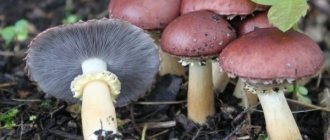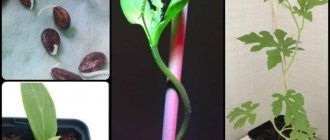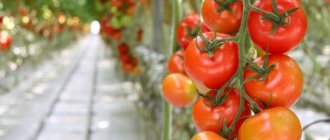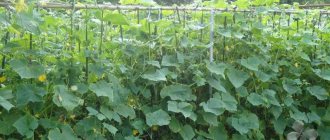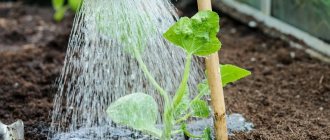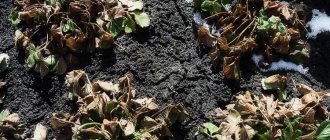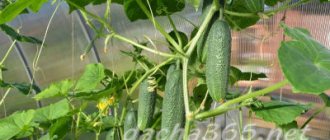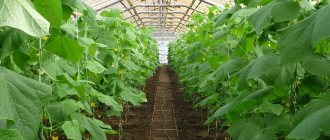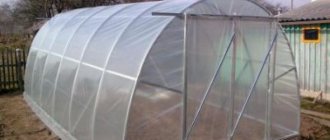Fresh cucumbers from your own greenhouse in the middle of winter - what could be tastier? With the development of modern technologies, growing vegetables in winter greenhouses is no longer a rarity. Getting fresh cucumbers to your table or for sale is quite simple. You just need to properly equip the greenhouse and follow the recommendations of experts on the choice of varieties and technology.
Growing cucumbers in a greenhouse in winter
What should a greenhouse be like for growing cucumbers in winter?
To grow cucumbers in winter, you need a greenhouse installed on a solid concrete foundation . Structures buried in the ground have proven themselves well. The soil layer plays the role of additional insulation. Due to the deepening, the structure is made less tall, without limiting the growth of the plant.
A well-thought-out heating system plays a vital role . Convectors, electric, water, infrared and wood heating are used. To preserve thermal energy, the winter greenhouse must be airtight.
Seed preparation
It is necessary to sort the seeds, removing bad and damaged ones. Next, you should place them in salted water and remove those that float to the surface and wash them off the salt. Gardeners select the disinfecting solution personally and purely individually. In order to disinfect seeds, diluted boric acid or potassium permanganate is good. Treated seeds can be kept in the refrigerator for about a week, placed on regularly moistened gauze, and used for planting.
Design
The best greenhouses for cucumber crops are constructed from polycarbonate , which is mounted on a metal frame with an anti-corrosion coating. A greenhouse is not cheap, but the costs are recouped in 2-3 years. A high-quality structure for growing cucumbers, tomatoes and other crops will bring the owners a harvest all year round.
In addition, it practically does not need repairs. Strong polycarbonate with a thickness of 100 mm will not crack under a large layer of snow and can easily withstand temperature changes. Some people use greenhouses made of tempered industrial glass, but this material is more fragile.
Heating and lighting
Most greenhouse structures are heated by electric boilers or compact wood stoves . The required air temperature is maintained using biofuel made from humus and straw, spread over the beds, as well as sheets of roofing felt placed around the perimeter of the greenhouse.
The lower the temperature outside, the more advanced the heating system should be . In particularly cold regions, combined heating is used, combining several methods at once.
Most often, cucumbers are grown in the ground, but for industrial purposes they practice rack cultivation of vegetables in 2-3 tiers . This method simplifies harvesting and significantly saves space.
In the winter season, when the days are short and solar activity is low, plants need additional lighting . To do this, install lamps of different types, observing two main parameters - illumination level and color temperature.
The culture requires light as close as possible to daylight . The lamp must have a color temperature of 5000 K. Metal halide (DNaT and DNa3), mercury (MGL) and fluorescent lamps have such lighting. During the growth stages of cucumbers, lighting devices with a color temperature of 6500 K are used, and during the flowering and fruiting period - about 4000 K. With these parameters, the crop does not stretch, remains strong and forms ovaries well.
Important! Fluorescent lamps are much inferior in light output - you will need much more of them for the same space. They heat up slightly, but are cheaper.
Requirements for soil and fertilizers
Cucumbers love light soil, neutral or slightly alkaline. Excessive acidity is unacceptable. The ideal soil consists of old garden soil, peat, rotted humus and river sand. Do not forget that the fertile soil layer changes annually, this is especially important when growing in shelves.
To feed cucumbers, you can alternate complex mineral and organic fertilizers, but some gardeners rely on organic matter. Cucumbers respond well to an aqueous solution of mullein or chicken droppings. The first fertilizing is carried out after the appearance of the third leaf on the seedlings, the second application of fertilizers begins during the flowering period. During fruiting, cucumbers are fed with organic matter at least 4 times.
Preparatory stage
To grow cucumbers in a greenhouse in winter, you need to choose the right variety . The process of preparing soil and seed material is of no small importance. The quality and quantity of the harvest directly depends on this.
Variety selection
For a winter greenhouse, varieties that are resistant to lack of light, low temperatures, do not require pollination, and are high-yielding are suitable. For these purposes, unpretentious early ripening parthenocarpic hybrids or special varieties for greenhouses :
- hybrids are crops bred by crossing two parental varieties: their name on the package with seeds contains the inscription F1 - these are April, Anyuta, Calendar, Zozulya, Lukhovitsky, Liliput, Makhaon, Dynamite and others;
- varieties resistant to light deficiency - Relay, Rossiysky, Regatta, Iva, Domashny, Marfinsky;
- unpretentious crops - Moscow greenhouse, Surprise, Grenade, Zarya.
Non-self-pollinating varieties require artificial pollination during the flowering period.
Soil preparation
The soil is enriched with organic and mineral fertilizers . When preparing the soil in new greenhouses, manure, potassium sulfate and superphosphate are added to the soil.
The finished substrate is infused for two weeks . Before planting plants in a permanent place, ammonium nitrate is added to the soil during loosening. To improve the quality of the soil, this event is carried out annually.
Interesting. California worms are capable of converting soil into vermicompost.
Seed preparation
To calibrate, they are placed in a saline solution for 15-20 minutes (1 teaspoon of salt per 1 glass). The seeds that float to the surface are removed - they will not sprout. The seeds that have fallen to the bottom are washed and dried.
Next, disinfection is carried out . The seeds are placed for 20-30 minutes in a 1% solution of potassium permanganate or 3% hydrogen peroxide, then washed. The procedure is carried out to increase the culture’s immunity to infectious diseases.
To harden the seeds, they are wrapped in damp cotton cloth, placed on a saucer and placed on the bottom shelf of the refrigerator for two days. Recommended temperature – from 0 to +2°С. This procedure is carried out to accelerate the emergence of seedlings and activate the immune system.
To stimulate culture growth, special preparations are used, for example, Zircon or Epin. The traditional method is also used: seeds are placed on an aloe leaf cut lengthwise overnight and planted in the morning without washing.
Features of care after transplantation
Cucumbers are a rather demanding crop . To achieve a good harvest, you will have to carefully monitor the level of moisture and soil fertility.
For good health and rapid formation of ovaries, cucumbers need fertilizing once every 2 weeks, alternating mineral and organic fertilizers. You also need to maintain high humidity - 80-85%. To ensure such indicators, the floor and heating pipes are regularly watered.
The greenhouse itself houses open tanks. They not only humidify the air, but also settle and heat water for irrigation.
Before the flowering period , plants are watered twice a week; after the flowers appear, watering becomes more frequent and abundant.
It is important to monitor the condition of the leaves; they should be elastic and juicy. Limp, drying leaves signal an acute lack of moisture in the soil.
Light intensity is very important for winter growing. Daylight hours should last at least 12 hours. Young plants are illuminated with low-hanging lamps; as the cucumbers grow, the lamps rise higher. It is believed that the condition of plants is positively influenced by the warm light spectrum.
The temperature should not fall below 20 degrees, the optimal regime is from 25 degrees during the day to 15 at night. Ventilation should be very careful, preventing cold air from entering the plants. Cucumbers stop forming ovaries even with short-term cold snaps, and this greatly affects the yield of cucumbers in the greenhouse in winter.
How to grow cucumbers in a greenhouse in winter
The technology for winter growing cucumbers in a greenhouse is practically no different from summer . However, it must be remembered that the air in a heated greenhouse is quite dry. For a moisture-loving cucumber, it can be destructive.
Growing seedlings and planting
Seedlings are painful to transplant , so seeds are most often planted in peat cups or tablets. Young plants are transplanted into the ground along with this container. This way the integrity of the root system is not compromised. The peat product becomes limp over time and dissolves in the soil.
To reduce the risk of seedlings becoming infected with rot, they are transplanted from other containers so that the root collar remains above the ground. Plants are planted in a permanent location at 25-30 days of age, when the bushes have 3-4 true leaves.
The density of planting depends on the selected variety (hybrid) . For 1 sq. m on average 2-4 bushes are planted. When planting in rows, 40-45 cm are left between plants. After planting, wire trellises are immediately installed. A special mesh or twine is tied to them.
Watering
The soil under the plants should be moderately moist . This is achieved by drip irrigation or regular moistening of plants at the root. The culture is watered with settled water at a temperature of +25-27°C. The soil is moistened to a depth of 10 cm, the soil is mulched with straw, sawdust or peat.
Water for irrigation is softened by adding a little organic matter (5-10 ml of mullein infusion or bird droppings per 10 liters of water). With such moisture, the plants will not require organic fertilizers. The crop will receive nutrition from irrigation, and soft water will be better absorbed by the roots.
Fertilizers
When sowing seeds, the first fertilizer is applied in the three-leaf phase . When planting seedlings, fertilizing is carried out after 2-4 days. For this purpose, fertilizer solutions are used, for example, “Nitrophoska”, “Kristallon” or “Kemira”. The concentration of drugs should not exceed 1-1.5%.
The second time the crop is fed during the period of mass formation of buds . For this, use “Nitrophoska” (5-10 g per 10 liters of water).
The third fertilization is carried out at the beginning of fruiting . During this period, potassium, phosphorus and magnesium are added. To prepare a solution, stir a glass of ash in 3-4 liters of warm water and leave for two days, then filter. Next, add water-soluble superphosphate and 1 teaspoon of potassium nitrate to the mixture, bring the solution to 10 liters and water along the furrows.
Foliar fertilization is carried out with the same solution , adding microelements to it. During fruiting, the crop is fed at intervals of 10-14 days with a filtered infusion of ash or a phosphorus-potassium composition. Also, a solution of nitrophoska is well suited as a fertilizer - 1.5 tbsp. l. on a bucket of water.
Garter and bush formation
A trellis is installed in the greenhouse, to which, as the crop grows, the ends of a strong rope or twine are tied, serving as a support for the lashes.
The lashes are tied up after the appearance of 6-8 leaves. To do this, one end of the lace is tied around the plant above the third or second leaf. Do not tighten the loop tightly, because the stem becomes thicker over time. The second end of the rope is tied to the trellis wire. Subsequently, the whip is periodically twisted around a vertically stretched cord (twine).
As the crop grows, they form bushes - pinch off all the side shoots so that they do not grow to the sides. This is done after 8-9 true leaves appear. New branches are removed at the lower 3-4 nodes, then at 4-5 nodes. In this case, one leaf or fruit is left. Above the fifth node, side lashes 20 cm long are left. The higher up the main stem, the longer the lashes are left.
Closer to the trellis, the length of the shoots should be approximately 50 cm; they are fixed on a support. When the top of the plant reaches the trellis, a lash of the main stem is wrapped around it and the top is pinched above the 2-3 leaves from the last fruit.
Disease and pest control
Growing cucumber crops in a greenhouse is becoming increasingly easier, since new hybrids with high resistance to diseases and pests appear every year. But still, a small risk of plant disease remains.
- Downy mildew - appears on the foliage as yellow or green oily spots, which darken over time, acquiring a brown tint. When a disease appears, watering and fertilizing are stopped. The disease is treated with a solution of polycarbacin or copper oxychloride. Spraying with systemic fungicides also helps effectively. After using the products, the greenhouse is ventilated. In case of peronosporosis, the air temperature during the day is maintained at no lower than +20°C, and at night at least +18°C.
- Powdery mildew - most often occurs with warming. A powdery coating appears on the leaves. The disease quickly destroys plants. Powdery mildew is eliminated using sulfaride, potassium permanganate or the preparations “Quadris 250 SC”, “Impact 25%”.
Often crops are attacked by aphids, which greatly complicates plant care. Small insects cause great harm to cucumbers. Damaged bushes have leaves wither and turn yellow, and buds and ovaries die.
Pests multiply quickly and can destroy an entire garden bed in a short period of time . To combat aphids, use a soap-ash solution. Add 2 tbsp to 1 liter of water. l. ash and laundry soap diluted in hot water. The leaves and stems of cucumbers are washed with this product. After five days, the procedure is repeated.
For your information. The soil under the bushes is sprinkled with ash. This repels pests and feeds weak plants when watering.
Harvesting
Mature cucumbers are harvested regularly so that they do not slow down the growth and appearance of new fruits. The crop is harvested in the morning or evening after watering.
Cucumbers for balconies and windowsills, which varieties are suitable
In order to grow cucumbers in an apartment, you need to choose the right variety. For winter sowing, it is better to give preference to hybrids that bear fruit well and are less demanding on growing conditions. These varieties include the following.
Courage. Ultra-early ripening period, from germination to harvest - 36 days. Advantages: good fruiting, large fruits.
Shchedrik . Ripening occurs 40 days after planting. Each node produces about 7 fruits. When grown on a windowsill, up to 25 fruits can be removed from a bush.
Khotorok . Ultra early ripening variety. The harvest can be harvested a month after planting. Zelentsy have a length of 10 cm, black thorns and good taste.
Crunchy. Late ripening variety. When grown at home, up to 40 fruits can be collected from one bush. The variety is vigorous and requires a lot of space to grow well.
Masha. Early ripening variety. The bush is dense, producing from 5 to 7 elongated fruits at each node.
Prestige . An early ripening variety with excellent taste. Advantages: fruit ripening occurs unevenly, therefore, the harvest can be harvested within a month.
To grow cucumbers at home, you can choose another variety you like, the main thing is that it is early ripening and self-pollinating.
When choosing a variety, it is necessary to take into account the type of flower and the height of the vine.
To grow cucumbers on a windowsill, you should give preference to pollinated varieties.
Growing cucumbers in winter as a business
Cultivating cucumbers in a greenhouse as a business has many advantages:
- heated structures allow you to harvest vegetables all year round;
- there are many varieties and hybrids that self-pollinate and are resistant to temperature changes and lack of light;
- the product is in great demand in stores and catering establishments;
- cucumbers are stored for a long time and do not spoil during transportation
- the price of this product rises significantly in winter, and there are fewer competitors.
When you decide to start industrial vegetable growing indoors, take into account the features of such a business :
- the construction and equipment of greenhouses requires large initial investments;
- heating in winter is expensive;
- To successfully grow cucumbers, you need a flat area with running water to organize an irrigation system;
- Cultivation of cucumbers requires fertilizer costs.
The profitability of a greenhouse for growing cucumbers for sale is 50-70% . In a good year it can exceed 100%. The greenhouse will pay for itself in about two years. As the area of the structure increases, the payback period shortens.
Soil work
It is necessary to complete the soil preparation in such a time as to sow in the last days of September and obtain harvests by the beginning of January. Next time you can sow by the end of the first month of winter. If the greenhouse is new, then it is necessary to prepare a mixture rich in organic elements, disinfect the soil, fertilize and dig it to a depth of approximately thirty centimeters.
Replacement and disinfection of soil
If the greenhouse is no longer new, then the gardener should remove the top layer of soil and replace it (about fifteen centimeters). The mixture may consist of humus and forest soil (it should be mixed in a one to one ratio). In peat-rich areas, high-moor peat is taken as the base and garden soil, not treated with herbicides and other chemicals, and humus are added to it in a ratio of 50:20:30%. The mixture must be carefully shoveled and the beds filled with it.
The next stage of preparation is soil disinfection. The most optimal method is one in which you need to spill the substrate with a solution of copper sulfate (concentration - from five to seven percent).
Application of fertilizers and special substances
The soil must be fed with mineral-based fertilizers, for example, kemira, nitrophoska. It is necessary to dig up the soil thirty centimeters. At the time of sowing, the soil should have a temperature of about twenty degrees above zero. About a week before sowing, to enrich the soil with beneficial microflora and eliminate negative elements, you need to add a solution of “Ekomik Urozhayny” or “Baikal EM-1” in a ratio of one hundred millimeters of substance per liter of water. Seeds are sown at the end of October or seedlings are planted in the last ten days of October.


